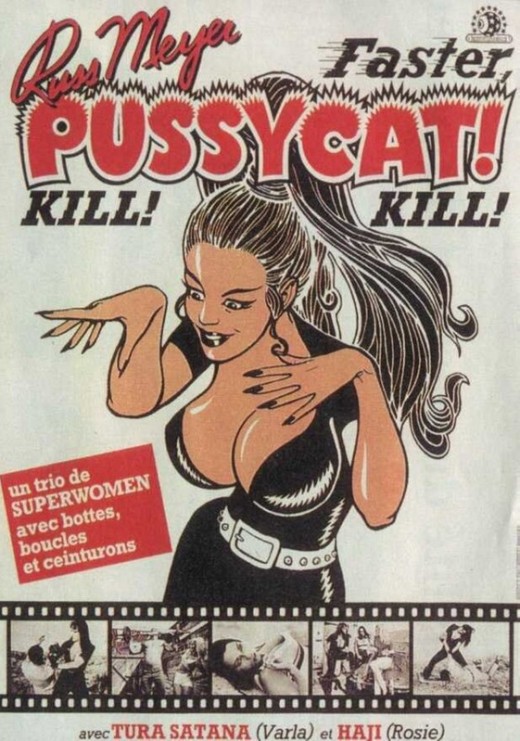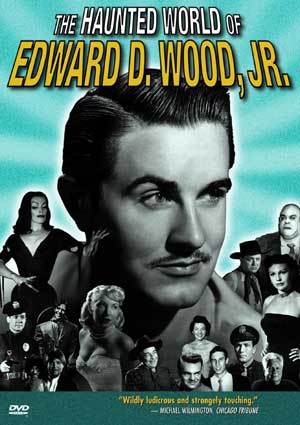"B" Movies: Call them Campy, Schlocky or Genius
The transformation of the film industry due to court rulings that brought an end to many long-standing distribution practices as well as the challenge of television led to major changes in U.S. cinema at the exhibition level. These shifts signaled the eventual demise of the double feature that had defined much of the American moviegoing experience during Hollywood's Golden Age of the 1930s and 1940s. Even as the traditional bottom-of-the-bill second feature slowly disappeared, the term B movie was applied more broadly to the sort of inexpensive genre films that came out during the era, such as those produced to meet the demands of the burgeoning drive-in theater market.
The term B movie retained its earlier suggestion that such movies relied on formulaic plots, "stock" character types, and simplistic action or unsophisticated comedy. At the same time, the realm of the B movie was becoming increasingly fertile territory for experimentation, both serious and outlandish.
Spurred by the historic success of several big-budget movies with B-style themes beginning in the mid-1970s, the major Hollywood studios moved progressively into the production of A-grade films in genres that had long been low-budget territory. With the majors also adopting exploitation-derived methods of booking and marketing, B movies began to be squeezed out of the commercial arena. The advent of digital cinema in the new millennium appeared to open up new opportunities for the distribution of inexpensive genre movies.

So...What is a "B" Movie?
The B movie was originally a motion picture made on a low or modest budget and intended as the second movie of a double feature during what was known as the "Golden Age of Hollywood." Although the production of the second feature, by and large, had ended by the late 1950s. The B movie still continues to be used when referring to any low-budget, commercial motion picture meant neither as an "arthouse film", "exploitation film" or even at times what many might consider "soft-core pornography." In its most common usage, B movies are mostly displayed as craft and aesthetic genius; on the other side of the coin, many view them as inexpensive exploitation films. In some cases, both are true.
In either usage, most B movies represent a particular genre-the Western was a Golden Age B movie staple, while low-budget science-fiction and horror films became more popular in the 1950s. Early B movies were often part of series in which the star repeatedly played the same character. Almost always shorter than the feature presentation that they were paired with, many had running times of 70 minutes or less. The term itself offered general notion that B movies were inferior to the high-budet headliners. B films were often ignored by critics. Ironically, many B movies still sometimes inspires multiple sequels. The term is also now used loosely to refer to some higher budgeted, mainstream films with exploitation-style content, usually in genres traditionally associated with the B movie.
From their beginnings to the present day, B movies have provided opportunities both for those coming up in the profession and others whose careers are waning. Celebrated filmmakers such as Anthony Mann and Jonathan Demme learned their craft in B movies. B movies are where actors such as John Wayne and Jack Nicholson became established, and the Bs have also provided work for former A movie actors, such as Vincent Price and Karen Black. Some actors, such as Béla Lugosi and Pam Grier, worked in B movies for most of their careers.
The 1960s and 1970s mark the golden age of the independent B movie, made outside of Hollywood's major film studios. As censorship pressures lifted in the early 1960s, the low-budget end of the American motion picture industry increasingly incorporated the sort of sexual and violent elements long associated with so-called exploitation films. The death of the Production Code in 1968 and the major success of the exploitation-style Easy Rider the following year fueled the trend through the subsequent decade. The success of the B-studio exploitation movement had a significant effect on the strategies of the major studios during the 1970s.
The growth of the cable television industry in the 1980s helped support the low-budget film market, as many B movies quickly wound up as "filler" material for 24-hour cable channels or were made expressly for that purpose. The broadcast version of the midnight movie remained popular: the nationally syndicated Movie Macabre package starring Cassandra Peterson-aka Elvira, Mistress of the Dark-was essentially a brassier copy of The Vampira Show, presenting mostly low-budget horror films interspersed with Elvira's satiric commentary and abundant display of cleavage. The video rental market was also becoming central to B-film economics: Empire's financial model, for instance, relied on seeing a profit not from theatrical rentals, but only later, at the video store. A number of Concorde-New Horizon releases appeared only briefly in theaters, or not at all.
By 1990, the cost of the average U.S. film had passed $25 million. The growing popularity of home video and access to unedited movies on cable and satellite television surviving B-movie operations adapted in different ways. Releases from many small production houses now went frequently straight to video. Along with real estate pressures were making survival more difficult for the sort of small- or non-chain theaters that were the primary home of independently produced genre films. Drive-in screens were rapidly disappearing from the American landscape: between 1987 and 1990, the number in operation fell from 2,507 to 910.
By the turn of the millennium, the cheesy, campy, guilty pleasures that used to bubble up with some regularity out of the B-picture ooze of cut-rate genre entertainment. Those cherished bad movies-full of jerry-built effects, abominable acting, ludicrous story lines-once flickered with zesty crudity in drive-ins and grind houses across the land. B-picture genres-science fiction and comic-book fantasy in particular, but also kiddie cartoons and horror pictures are now dominated by the A-list, commanding the largest budgets and the most attention from the market-research and quality-control departments of the companies that manufacture them.... For the most part, the schlock of the past has evolved into star-driven, heavily publicized, expensive mediocrities. At the same time, over the past 2-3 years, the quality of digital filmmaking has improved dramatically. Independent filmmakers, whether working in a genre or arthouse mode, continue to find it difficult to gain access to distribution channels, though so-called digital end-to-end methods of distribution offer new opportunities. The so-called day-and-date strategy, in a which a film is released simultaneously in theaters as well as DVD and/or cable, may offer a way for the true low-budget B movie to regain some of the audience it has lost. In a similar fashion, the popularity of Internet sites such as YouTube have opened up entirely new avenues for the presentation of motion pictures made on a shoestring. Watching films on computer is the possible future, it's also a direct connection to the audience giving experimental films a chance to shine once again.
The Alien Segment of "It Came From Hollywood"

10 Cult Films on DVD
This is not even close to a difinititve list. This is just a "jumping -off point"
1. 'Harold and Maude'
If you want to be free, be free. From the Cat Stevens soundtrack to Bud Court's inventive suicide attempts to the stunning Pacific coastline, Hal Ashby's timeless film pleases on every level.
2. 'Reservoir Dogs'
"O.K., let me tell you what 'Like a Virgin's' about." This early Quentin Tarantino masterpiece reinvented the landscape of independent film with this super cool heist flick. The terrific ensemble cast includes Steve Buscemi, Tim Roth, Harvey Keitel, and Tarantino as Mr. Brown.
3. 'The Worst of Ed Wood' Boxed Set
This four-disc set captures the entire low budget and terrificly campy Ed Wood collection: Glen and Glenda, Plan 9 from Outer Space, Bride of the Monster, and Mesa of Lost Women, plus the documentary Flying Saucers over Hollywood.
4. 'Brazil'
It depends on your comic sensibilities if you find this distopian fantasy funny or tragic, but there is no doubt in my mind director Terry Gilliam created a masterpiece. The Criterion Collection offers an excellent three-disc set with alternate versions and extras galore.
5. 'John Waters Collection Volume 3: The - Pink Flamingos/ Female Trouble'
John Waters broke almost every rule of filmmaking and good taste with Pink Flamingos. As an extra bonus, the DVD also contains Female Trouble, a tribute to good-girl-gone-bad drive-in melodramas, and a commentary track by John Waters himself.
6. 'Ghost Dog - The Way of the Samurai'
Jim Jarmusch really got me with this one. The sublime Forest Whitaker stars as Ghost Dog, a man of few words who shares his rooftop home with dozens of pigeons. A cross-cultural fusion of Eastern philosophy, hip-hop music, and urban violence.
7. 'Twin Peaks: The First Season Special Edition'
David Lynch's twisted television masterpiece makes great home viewing. Who isn't a freak? Is there anybody normal in this town? Nope, sorry. Eight hours of entertainment can't be beat, with special features galore, including cast interviews, episode analysis, and extra scenes.
8. 'Drug Store Cowboy'
Before Gus Van Sant went mainstream, he made seemingly effortless offbeat movies about terrific characters. Matt Dillon, Kelly Lynch, James Le Gros, and an undiscovered Heather Graham play a small group of drug addicts who heist pharmacies to feed their habit.
9. 'Gummo'
Harmony Korine was only 23 when he wrote and directed this film. It's a raw, improvised take on small town life in Ohio, and Korine doesn't care if you find fights with kitchen furniture or skinning cats disturbing or not. You have to love the bunny ears.
10. 'Repo Man'
Harry Dean Stanton and Emilio Estevez star in Alex Cox's punk sci-fi classic about two guys who repossess cars.



